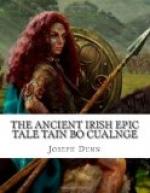Version B comprises the closely related accounts of the Tain as contained in the Book of Leinster (abbreviated LL.) and the following MSS.: Stowe 984 (Royal Irish Academy), written in the year 1633 and giving, except for the loss of a leaf, a complete story of the Tain; H. 1. 13 (Trinity College, Dublin), written in the year 1745 and giving the Tain entire; Additional 18748 (abbreviated Add.), British Museum, copied in the year 1800 from a 1730 original; Egerton 209 and Egerton 106 (British Museum), both fragments and dating from the eighteenth century. Fragments of a modern version are also found in MS. LIX, Advocates’ Library, Edinburgh.
To version C belong only fragments: H. 2. 17 (Trinity College, Dublin), dating from the end of the fourteenth or the beginning of the fifteenth century; the almost identical Egerton 93 (British Museum), consisting of only ten leaves and dating from nearly a century later, and H. 2. 12 (Trinity College, Dublin), consisting of only two pages.[8]
The manuscripts belonging to each of these versions, A, B, and C, have sufficient traits in common to place them in a group by themselves. The question of the relationship of these manuscripts to one another and of the character of the suppositional archetype from which they are all descended is a most intricate one and one which has given rise to considerable discussion. The question still awaits a definite answer, which may never be forthcoming, because of the disappearance not only of the first draft of the Tain, but also of that of some of its later redactions. We must not overlook the possibility, either, of an otherwise faithful copyist having inserted in the text before him a passage, or even an entire episode, of his own fabrication. This, no doubt, happened not infrequently, especially in the earlier period of the copying of Irish manuscripts, and a single insertion of this kind, or the omission, intentionally or by oversight, of a part of the original from the copy might, it will easily be seen, lead one to conclude that there once existed a form of the story which as a matter of fact never existed.
The version of the Tain which I have chosen as the basis for my translation is the one found in the Book of Leinster (Leabhar Laighneach), a voluminous vellum manuscript sometime called the Book of Glendalough and now kept in the Library of Trinity College, Dublin, catalogue number H. 2. 18. Only a part of the original book remains. It dates from about the year 1150. This date is established by two entries in the manuscript itself: “Aed son of Crimthann (Hugh macGriffin) hath written this book and out of many books hath he compiled it” (facsimile, at the bottom of page 313). Who this Aed was will be clear from the other entry. It appears that he had lent the manuscript while still unfinished to Finn macGorman, who was Bishop of Kildare from 1148 and died in the year 1160, and who on returning the book wrote in it the following laudatory note in Irish




